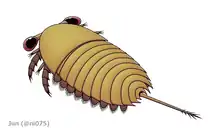Sarotrocercus
Sarotrocercus is a small Cambrian arthropod known from Burgess shale, reaching a centimetre or two in length (0.39–0.79 in).[1] 28 specimens of Sarotrocercus are known from the Greater Phyllopod bed, where they comprise < 0.1% of the community.[2] It may lie in the arthropod crown group, and a recent study has revised some points of its original description.[3]
| Sarotrocercus Temporal range: | |
|---|---|
 | |
| Reconstruction of Sarotrocercus | |
| Scientific classification | |
| Kingdom: | Animalia |
| Phylum: | Arthropoda |
| Class: | incertae sedis |
| Genus: | †Sarotrocercus |
| Species: | †S. oblitus |
| Binomial name | |
| †Sarotrocercus oblitus Whittington, 1981 | |
Morphology
Sarotrocercus had a head shield followed by a trunk of 10 or 11 segments and a telson featuring a series of spines on the end.[3] A pair of big eyes at the end of stalks ventrally emerged from the front of the head.[3] The head bore two pairs of sturdy appendages that are armed with rows of inner spines.[3] At least the anterior 9 trunk segments each possess a pair of appendages, which are only known by lobe-like exopods that are fringed with setae.[3]
Ecology
In the original description, Sarotrocercus had been interpreted as a pelagic, nektonic animal that swam freely on its back, moving perhaps through movements of the trunk appendages and the action of its long tail tuft.[4] This was mainly based on the rarity of the specimens, as the Burgess Shale contains few swimming organisms; the submarine landslides that buried organisms mainly smothered benthic and nektobenthic organisms.[4][5] However, based on the redescription by Haug et al. 2011, Sarotrocercus may had been benthic or at least swimming close to the seafloor, as the robust head appendages rather suggest a grasping or raking function.[3]
External links
- "Sarotrocercus oblita". Burgess Shale Fossil Gallery. Virtual Museum of Canada. 2011.
References
- Briggs, D. E. G.; Erwin, D. H.; Collier, F. J. (1995), Fossils of the Burgess Shale, Washington: Smithsonian Inst Press, ISBN 1-56098-659-X, OCLC 231793738
- Caron, Jean-Bernard; Jackson, Donald A. (October 2006). "Taphonomy of the Greater Phyllopod Bed community, Burgess Shale". PALAIOS. 21 (5): 451–65. doi:10.2110/palo.2003.P05-070R. JSTOR 20173022.
- Haug, J.T.; Maas, A.; Haug, C.; Waloszek, D. (2011). "Sarotrocercus oblitus - Small arthropod with great impact on the understanding of arthropod evolution?". Bulletin of Geosciences: 725–7??. doi:10.3140/bull.geosci.1283.
- Whittington, H.B. (1981). "Rare Arthropods from the Burgess Shale, Middle Cambrian, British Columbia". Philosophical Transactions of the Royal Society of London. Series B, Biological Sciences. The Royal Society. 292 (1060): 329–357. Bibcode:1981RSPTB.292..329W. doi:10.1098/rstb.1981.0033. JSTOR 2395674.
- Gabbott, S.E.; Zalasiewicz, J.; Collins, D. (2008). "Sedimentation of the Phyllopod Bed within the Cambrian Burgess Shale Formation of British Columbia". Journal of the Geological Society. 165 (1): 307–318. Bibcode:2008JGSoc.165..307G. doi:10.1144/0016-76492007-023. S2CID 128685811.